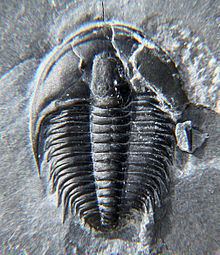Superfamily Anomocaroidea | Class Trilobita Family Parabolinoididae Rank Genus | |
 | ||
Similar Emigrantia, Wanneria, Estaingia bilobata, Asaphida, Redlichia takooensis | ||
Orygmaspis is a genus of asaphid trilobite with an inverted egg-shaped outline, a wide headshield, small eyes, long genal spines, 12 spined thorax segments and a small, short tailshield, with four pairs of spines. It lived during the Upper Cambrian in what are today Canada and the United States.
Contents
Description
The outline of the exoskeleton Orygmaspis is inverted egg-shaped, with a parabolic headshield (or cephalon less than twice as wide as long. The well-defined central raised area (or glabella), excluding the backward occipital ring, is ¾× as wide as long, moderately convex, truncate-tapering, with 3 pairs of shallow to obsolete lateral furrows. The occipital ring is well defined. The distance between the glabella and the border (or preglabellar field) is ±¼× as long as the glabella. Eyes small to almost medium, 12-20% of the length of the cephalon, positioned between the front and the middle of the glabella and about ⅓ as far out as the glabella is wide. The remaining parts of the cephalon, called fixed and free cheeks (or fixigenae and librigenae) are flat. The fracture lines (or sutures) that in moulting separate the librigenae from the fixigenae are divergent just in front of the eyes, becoming parallel near the border furrow and strongly convergent at the margin. From the back of the eyes the sutures are bending out, than in, diverging outward and backward at approximately 45°, cutting the posterior margin well within the inner bend of the spine (or opisthoparian sutures). The articulating middle part of the body (or thorax) has 12 segments. The anteriormost segment gradually narrows into a sideward directed point, while further to the back the spines are directed outward and the spine is of increasing length up until the ninth, while the spine on the tenth segment is abruptly much smaller, and 11 and 12 even more so. The small tailshield (or pygidium) is about ⅓× as wide as the cephalon, narrowly transverse about 2× wider than long. Its axis is slightly wider than the pleural fields to each side, and has up to 4 axial rings and a terminal and almost reaches the margin. Up to 4 pleural segments with obsolete interpleural grooves and shallow pleural furrows. The posterior margin has 3 or 4 pairs of spines, getting smaller further to the back. The surface has fine granules or is smooth.
Taxonomy
O. llanoensis and O. firma seem to represent the extremes in morphology of a continuous grade.
